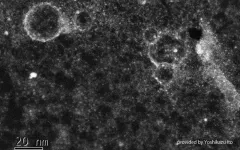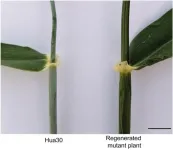(Press-News.org)
A groundbreaking study conducted by Jun Sun’s research team at the University of Illinois Chicago has revealed a new and critical role of Axin1 in regulating intestinal epithelial development and microbial homeostasis. The research, published in the journal Engineering, highlights the potential therapeutic strategies for human inflammatory bowel disease (IBD).
IBD, a chronic inflammatory disorder affecting the gastrointestinal tract, has been a significant health concern worldwide. The study focused on understanding the role of Axin1, a negative regulator of Wnt/β-catenin signaling, in maintaining gut homeostasis and host response to inflammation.
The research team analyzed Axin1 expression in human inflammatory bowel disease datasets and found increased Axin1 expression in the colonic epithelium of IBD patients. To further investigate the effects and mechanism of intestinal Axin1 in regulating intestinal homeostasis and colitis, the team generated new mouse models with Axin1 conditional knockout in intestinal epithelial cells (Axin1ΔIEC) and Paneth cells (Axin1ΔPC).
The results showed that Axin1ΔIEC mice exhibited altered goblet cell spatial distribution, Paneth cell morphology, reduced lysozyme expression, and an enriched presence of Akkermansia muciniphila (A. muciniphila) in the gut microbiota. Importantly, the absence of intestinal epithelial and Paneth cell Axin1 led to decreased susceptibility to dextran sulfate sodium-induced colitis in vivo.
Furthermore, when Axin1ΔIEC and Axin1ΔPC mice were cohoused with control mice, they became more susceptible to dextran sulfate sodium (DSS)-colitis, suggesting the protective role of Axin1 in the presence of a healthy gut microbiota. Treatment with A. muciniphila further reduced the severity of DSS-colitis, highlighting its potential as a therapeutic target.
Interestingly, antibiotic treatment did not change the proliferation of intestinal epithelial cells in the control mice. However, in Axin1ΔIEC mice with antibiotic treatment, the intestinal proliferative cells were significantly reduced, indicating the non-colitogenic effects driven by the gut microbiome.
These findings demonstrate the novel role of Axin1 in mediating intestinal homeostasis and the microbiota. The loss of intestinal Axin1 protects against colitis, likely through the regulation of epithelial Axin1 and Axin1-associated A. muciniphila. Further mechanistic studies using specific Axin1 mutations will be crucial in elucidating how Axin1 modulates the microbiome and host inflammatory response, paving the way for new therapeutic strategies for human IBD.
Jiaming Wu, editor of the subject of medicine and health of Engineering, commented, “This study provides valuable insights into the development of inflammatory bowel disease and offers potential therapeutic strategies for its treatment. By understanding the intricate interactions between Axin1, the gut microbiota, and host immunity, researchers can develop targeted interventions to restore intestinal homeostasis and alleviate the symptoms of IBD.”
The research team’s findings have significant implications for the field of gastroenterology and hold promise for the development of novel treatments for IBD. As further studies are conducted, the scientific community eagerly awaits the potential therapeutic breakthroughs that may arise from this research.
The paper “Profiling the Antimalarial Mechanism of Artemisinin by Identifying Crucial Target Proteins”, authored by Shari Garrett, Yongguo Zhang, Yinglin Xia, Jun Sun. Full text of the open access paper: https://doi.org/10.1016/j.eng.2023.06.007. For more information about the Engineering, follow us on Twitter (https://twitter.com/EngineeringJrnl) & like us on Facebook (https://www.facebook.com/EngineeringPortfolio).
About Engineering
Engineering (ISSN: 2095-8099 IF:12.8) is an international open-access journal that was launched by the Chinese Academy of Engineering (CAE) in 2015. Its aims are to provide a high-level platform where cutting-edge advancements in engineering R&D, current major research outputs, and key achievements can be disseminated and shared; to report progress in engineering science, discuss hot topics, areas of interest, challenges, and prospects in engineering development, and consider human and environmental well-being and ethics in engineering; to encourage engineering breakthroughs and innovations that are of profound economic and social importance, enabling them to reach advanced international standards and to become a new productive force, and thereby changing the world, benefiting humanity, and creating a new future.
END
Tsukuba, Japan—Fuel cells are attracting attention as a clean energy source technology because the cells do not produce carbon dioxide and emit only water during power generation. However, two contradictory phenomena can hamper their performance: flooding, wherein water remains inside the fuel cell and interferes with power generation, and dry-out, wherein an excess of water is removed and the polymer membrane, through which hydrogen ions permeate, dries out. To detect such issues, various devices and sensors have been used in analyses based on substantial amounts of data.
This research team has been investigating a method for detecting and controlling ...
Tsukuba, Japan—For realizing carbon neutrality, the demand for the development of direct methanol/formic acid-fuel cell technology has been increasing. In this technology, methanol or formic acid is used as an e-fuel for generating electricity. The fuel cells generate electricity via proton transfer; however, conventional proton-exchange membranes suffer from the "crossover phenomenon," where the fuel molecules are also transferred between anodes and cathodes. Thereafter, the fuel molecules are unnecessarily oxidized and the electrodes are deactivated. In this study, the researchers developed a new proton-exchange ...
Tsukuba, Japan—The search for functional natural compounds that can improve age-related cognitive decline has recently emerged as an important research focus to promote healthy aging. Trigonelline (TG), a plant alkaloid found in coffee, as well as in fenugreek seed and radish, was anticipated to possess cognitive enhancement properties. In this study, researchers led by the University of Tsukuba investigated the effects of TG on memory and spatial learning (acquiring, retaining, structuring, and applying information related to the surrounding physical environment) from both a cognitive and molecular biology perspective ...
Tsukuba, Japan—In eukaryotes, genomic DNA, which is a very long double helix containing all the genetic information, wraps around a globular protein called a histone and folds it many times before being contained within the nucleus. Various post-translational modifications (for example, addition of chemical groups) occur on histones. Among them, the methylation of residues of lysine, which is one of the amino acids that make up histones, regulates the folding of genomic DNA and acts as a switch to turn gene transcription on and off.
The research group has discovered the methylation of histidine residues as a new post-translational ...
This study is led by Dr Cheng-Guo Duan (Center of Excellence in Molecular Plant Sciences, Chinese Academy of Science). As a conserved epigenetic mark, DNA cytosine methylation at 5’ position (5-mC) plays important roles in multiple biological processes including plant immunity. While, it remains still elusive about the involvement of DNA methylation in the determinants of virulence of phytopathogenic fungi. Verticillium dahliae, one of the major causal pathogens of Verticillium wilt disease that causes great losses in many crops, has a wide host range. Due to the lack of natural disease-resistant ...
This study combined expertise in barley genetics and genomics from the research group led by Dr. Ping Yang (Institute of Crop Sciences, Chinese Academy of Agricultural Sciences) and that in barley microspore culturing led by Dr. Chenghong Liu (Biotech Research Institute, Shanghai Academy of Agricultural Sciences), in order to address the time- and space-cost issue in developing homozygous induced mutants, which are very important genetic resources in theoretical researches as well as pre-breeding.
The researchers applied chemical mutagenesis (ethyl ...
Artifical intelligence not only affords impressive performance, but also creates significant demand for energy. The more demanding the tasks for which it is trained, the more energy it consumes. Víctor López-Pastor and Florian Marquardt, two scientists at the Max Planck Institute for the Science of Light in Erlangen, Germany, present a method by which artificial intelligence could be trained much more efficiently. Their approach relies on physical processes instead of ...
DURHAM, N.C. – Maintaining a water level between 20 and 30 centimeters below the local water table will boost southern peatlands’ carbon storage and reduce the amount of climate-warming carbon dioxide (CO2) and methane they release back into the atmosphere during dry periods by up to 90%, a new Duke University study finds.
“We could immediately reduce U.S. carbon losses by 2% to 3% of our total national goal by applying this guideline on about 100,000 acres of restored or partially restored peatlands currently found across ...
A research team, led by Professor Jong-Beom Baek and his team in the School of Energy and Chemical Engineering at UNIST have achieved a significant breakthrough in battery technology. They have developed an innovative method that enables the safe synthesis of fluorinated carbon materials (FCMs) using polytetrafluoroethylene (PTFE) and graphite.
Fluorinated carbon materials have garnered considerable attention due to their exceptional stability, attributed to the strong C-F bonding—the strongest among carbon single bonds. However, traditional methods of fluorination involve highly toxic reagents such as hydrofluoric acid (HF), making them unsuitable for practical ...
As energy demand continues to rise, research into new, efficient renewable and clean energy sources is an urgent priority. Currently, renewable energy sources like solar, wind, tide, and geothermal make up less than 40% of the current energy demand. Increasing this percentage and reducing the amount of fossil fuels used will require other, more efficient renewable and clean energy sources.
Hydrogen is a promising alternative, but it is currently produced using steam reforming, which is inefficient and produces CO2 emissions. Electrochemical water splitting, also called ...






